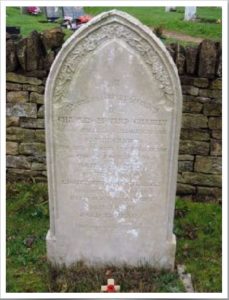‘A’ Battery, Royal Canadian Horse Artillery

Charles Edward Chainey was born at Blockley, then part of Worcestershire, on 9 December 1886 and he was the son of William Frederick and Sarah Chainey.
According to the 1911 census this couple had fourteen children (all but one surviving at 1911). William Chainey was the landlord of the Crown Hotel, High Street, Blockley.
Charles worked as a farm labourer and there is evidence to suggest that he emigrated to Canada on 24 March 1910, sailing from Liverpool to Halifax, Nova Scotia or St John’s, Newfoundland.
Thanks to the ongoing digitisation of Canadian Army records from 1914-18 and their availability online, details of Gunner Chainey’s army service are now available. He enlisted into the Canadian Army at Valcartier, Quebec on 20 September 1914 (stating his occupation as a farmer and age 27 years six months) and joined the Royal Canadian Horse Artillery, serving with ‘A’ Battery. He left Canada for Britain on 3 October 1914 but does not appear to have landed in France until 20 July 1915. He served in the field from thereon, except for the period 24 to 30 January 1916, when he was in hospital with influenza.
He was wounded near Cambrai on 1 December. On 30 November the Germans had mounted a powerful counter attack, to try to regain the ground lost to the British and Dominion forces, when, using tanks in great numbers (376), they had smashed through the Hindenburg Line defences and made significant gains. He had suffered two gunshot wounds to his left thigh, as well as superficial wounds to face and right hand. He was initially admitted to 61 Field Ambulance before being transferred to 55 Casualty Clearing Station, before ending up at 16 General Hospital at Le Treport. From here he was transported by hospital ship to England on 11 December and on 13 December was admitted to Crag Head Hospital, a large house, converted for hospital use, on the East Cliff at Boscombe (the house was demolished in 1972).
On 15 December he was reported as dangerously ill, his wound had become infected and he has also contracted tetanus, indicated by a stiffening of the jaw, reported on 17 December. There was a steady deterioration of his condition and he died at 5.50am on 22 December 1917, age 31.
He was brought home to Blockley for burial, where his grave is marked by a headstone placed by his family: this states that he died of wounds received in France.
The headstone also commemorates his brother, 8/3208 Private Lionel Wilson Chainey, who died on 3 December 1917, whilst serving with 1st Otago Regiment, New Zealand Expeditionary Force.
He has no known grave and is commemorated on the New Zealand Memorial at Buttes New British Cemetery, Polygon Wood, Belgium.
In his ‘soldier’s will’ he left his ‘real estate’ to his nephew, William Chainey, of Lethbridge, Alberta and his ‘personal estate’ to his father, of the Crown Hotel, Blockley.
Researched by Graham Adams 17 March 2015 (revised)
